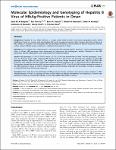Molecular Epidemiology and Genotyping of Hepatitis B Virus of HBsAg-Positive Patients in Oman
Baqlani, Said Ali Al
Sy, Bui Tien
Ratsch, Boris A.
Naamani, Khalid Al
Awaidy, Salah Al
Busaidy, Suleiman Al
Pauli, Georg
Bock, Thomas
Background: Hepatitis B virus (HBV) infection is a major global health burden with distinct geographic public health significance. Oman is a country with intermediate HBV carrier prevalence; however, little is known about the incidence of HBV variants in circulation. We investigated the HBV genotype distribution, the occurrence of antiviral resistance, and HBV surface antigen (HBsAg) escape mutations in HBsAg-positive patients in Oman. Methods: Serum samples were collected from 179 chronically HBV-infected patients enrolled in various gastroenterology clinics in Oman. HBV genotypes were determined by sequencing and phylogenetic analysis. Mutations in the HBV polymerase and the HBsAg gene were characterized by mutational analysis. Results: HBV genotypes D (130/170; 76.47%) and A (32/170; 18.28%) are predominant in Oman. The HBV genotypes C and E were less frequent (each 1.18%), while the HBV genotypes B, G, F, and H were not detected. Four patients revealed HBV genotype mixtures (HBV-A/D and D/C). The analyses of vaccine escape mutations yield that 148/170 (87.06%) HBV sequences were wild type. 22/170 (12.94%) HBV sequences showed mutations in the “a” determinant of the HBsAg domain. Two patients showed the described HBV vaccine escape mutation sP120T. 8/146 (5.48%) HBV isolates harbored mutations in the HBV polymerase known to confer resistance against antiviral therapy. Especially the lamivudine resistance mutations rtL180M/rtM204V and rtM204I were detected. Conclusion: This study shows the distribution of HBV genotypes, therapy resistance, and vaccine escape mutations in HBV-infected patients in Oman. Our findings will have a major impact on therapy management and diagnostics of chronic HBV infections in Oman to control HBV infection in this intermediate HBV-endemic country.
Dateien zu dieser Publikation
Keine Lizenzangabe
Verwandte Publikationen
Anzeige der Publikationen mit ähnlichem Titel, Autor, Urheber und Thema.
-
2022-01-14ZeitschriftenartikelEpidemiologie der Virushepatitiden A bis E in Deutschland Dudareva, Sandra; Faber, Mirko; Zimmermann, Ruth; Bock, C.-Thomas; Offergeld, Ruth; Steffen, Gyde; Enkelmann, JuliaMit Virushepatitis A bis E werden verschiedene infektiöse Entzündungen des Leberparenchyms bezeichnet, die durch die Hepatitisviren A bis E (HAV, HBV, HCV, HDV und HEV) ausgelöst werden. Zwar ähneln sich die Krankheitsbilder, ...
-
2022-01-14ZeitschriftenartikelEpidemiologie der Virushepatitiden A bis E in Deutschland Dudareva, Sandra; Faber, Mirko; Zimmermann, Ruth; Bock, Claus-Thomas; Offergeld, Ruth; Steffen, Gyde; Enkelmann, JuliaMit Virushepatitis A bis E werden verschiedene infektiöse Entzündungen des Leberparenchyms bezeichnet, die durch die Hepatitisviren A bis E (HAV, HBV, HCV, HDV und HEV) ausgelöst werden. Zwar ähneln sich die Krankheitsbilder, ...
-
2015-07-06ZeitschriftenartikelOccult Hepatitis B Virus Infection in Nigerian Blood Donors and Hepatitis B Virus Transmission Risks Oluyinka, Opaleye O.; Tong, Hoang Van; Tien, Sy Bui; Fagbami, Ademola H.; Adekanle, Olusegun; Ojurongbe, Olusola; Bock, Thomas; Kremsner, Peter G.; Velavan, Thirumalaisamy P.Background: Occult hepatitis B virus infection (OBI) characterized by the absence of detectable HBsAg remains a potential threat in blood safety. We investigated the actual prevalence, viral factors and genotype of OBI ...

